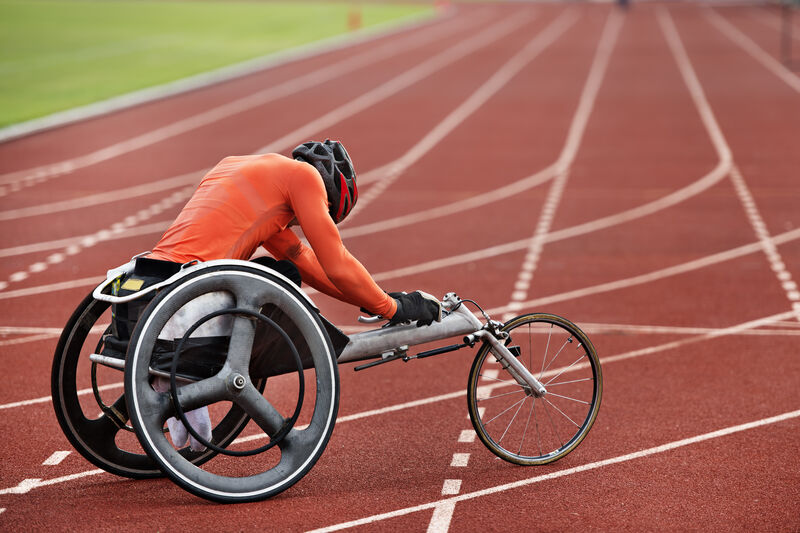
In late 2021, I was asked to sit in on a webinar discussion panel to talk about the ADA requirements for Temporary events. The webinar was hosted by USA Triathlon and aimed at organizers of triathlon and running events. It was a very fun conversation to be a part of. These types of temporary events are required to be as accessible as any other type of place of public accommodation. I wanted to highlight some of the areas of the discussion. This is the 2nd portion of a 2-part entry. Last month, I introduced the types of equipment people with disabilities might use to participate in these events. I also talked about reasonable modifications and best practices to ensure people with sensory disabilities can participate, as well. I wish to address two broad topics today: physical access and why bother?
At these kinds of events, I think it’s helpful to break physical access down into 2 parts: The racecourse and everything else. The ADA Generally does not require fundamental alterations to be made to the playing field. While not a baseball diamond or football field, the “field of play” for these events is effectively the community where the event is located. Moreover, it would not be reasonable to repave a city street for an annual 5k. These events are inherently challenging, and a race organizer has the right to design as challenging of a course as they see fit. The ADA allows for the person with a disability to decide how best they may participate in a sport in the normal field of play. The ADA also requires an accessible route to get to the field of play.
While the racecourse may not need to be made accessible, proper planning should be implemented to create access to the circuit. Start with site arrival points. Accessible routes should be provided through the public-right-of-way. Ensure that signage directing people to the registration/packet-pickup areas do not obstruct the accessible route. Perform a physical walk-through of the intended route from site arrival points to all areas participants are expected to go. This includes provided porta potties, medical tents, and food/vendor areas. Lining up porta potties along a curb looks good but isn’t useable for people in wheelchairs. Be sure to provide at least 1 wheelchair accessible porta potty at every location a porta potty is provided. If amenities are located along the race route, make sure there’s a way to get to them for people with disabilities. Use existing curb ramps in the right of way to locate these features. Use temporary ramps to provide access over curbs that can’t be avoided.
Some will ask, why bother? Sometimes, people will argue that people with disabilities do not participate in these events. They state that it’s a waste of time and energy. Let’s break these arguments down and see if they hold water.
If temporary events are not accessible, people with disabilities can’t participate. It’s not a choice if access isn’t provided. If your town doesn’t have a pizza parlor, you can’t order out for pizza. It’s not that you don’t enjoy pizza. It’s not that you don’t want to order pizza. It’s because ordering pizza is not accessible where there’s no pizza parlor. There is a stigma, old attitudes, that people with disabilities do nothing but stay in their homes. This is not true. Just as able-bodied people have a choice to seek out activity or remain sedentary, so do people with disabilities.
As a bike racer, I can speak for everyone participating in one of these types of events that the restroom is critical for participation. There is always a line for the restroom before these types of events. Would you attend a long event where you were reasonably sure you would not be able to use a restroom the entire time?
Yes, ensuring accessibility does take more effort. Yes, wheelchair accessible porta potties are more expensive. However, does it not take effort to organize an event in general? Does it not cost money to rent porta potties in general? Why should providing for everyone not be the normal way? Yes, it takes a little more money and effort, but like many things in life, you reap what you sow. If your organization qualifies as a small business, you may even be entitled to tax incentives for providing access through the IRS tax code. Speak to your CPA to see if you qualify.
As the quote goes from the movie Field of Dreams, “If you build it, they will come.” If you create accessible events, participation of people with disabilities will start to increase. It may not be in huge numbers or immediately but allowing the possibility will lead to growth. Conversely, participation cannot increase if they are clearly not welcome.
What’s the point of organizing these events? I’d say it’s to provide an outlet for people within a community to enjoy, to congregate with one another, and to enjoy the community. Why not include everyone within that community? Why stop at 95%? Healthy communities thrive. People thrive when they have an outlet, when they feel they belong.